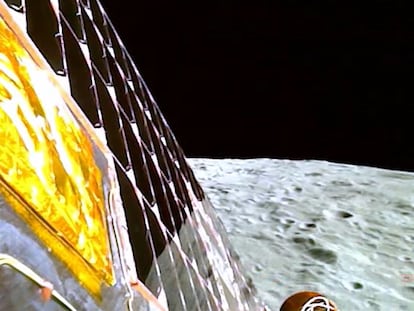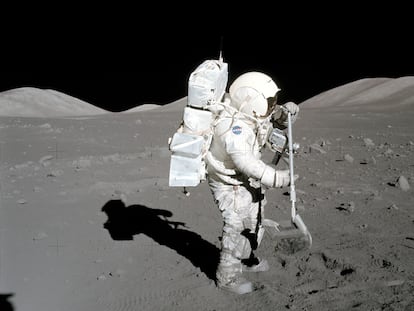Water on the Moon and the civilizations of the future
The origin of the water that our satellite contains is unknown, but the process of deciphering it will provide clues about how it arrived on Earth

All the great ancient civilizations were aware of the importance of water; it is no coincidence that Egyptian culture developed on the banks of the Nile, Mesopotamian culture between the Euphrates and the Tigris, or Chinese culture in the basin of the Huang River. For the Romans, those great transporters of water, the availability of abundant water was considered a symbol of wealth and, therefore, of power.
There is not a single major city on Earth that is not located on the banks of a river or near to a copious source of fresh water. It should come as no surprise, then, that what is to be secured on the Moon as a first step toward future settlement is precisely that.
As early as 1961, the possibility was put forward that ice might be found in cold depressions located at the lunar poles, in regions of permanent shadow that exist because of the Moon’s low obliquity. In particular, large impact craters located at high latitudes offer protection from solar radiation throughout the lunar day. And this is true for both the walls and the floor of the crater, as well as for the smaller craters within the large ones. There are approximately half a million of these on the entire surface of the Moon, with some measuring up to one kilometer (0.62 miles) in diameter.
It is precisely in one of these young craters that NASA’s Moon Mineralogy Mapper instrument, M3, carried aboard the Indian Space Research Organisation’s Chandrayyan-1, the country’s first mission to our satellite, found evidence of a water footprint in 2008. Confirmation would come a year later, when the upper stage of the rocket used to launch NASA’s Lunar Reconnaissance Orbiter deliberately crashed into a crater at the Moon’s south pole. The Lunar Crater Observation and Sensing Satellite’s flyby through the debris plume detected 155 kilograms of water before it too impacted on the lunar surface.
The amount of water the Moon might hold is extremely uncertain, but it is estimated that it may contain 10 billion times less than the Earth’s oceans alone, and our satellite is only 81 times smaller than our planet. But if the Moon is close to Earth and the main feature of the blue planet is water, why isn’t that the case for the Moon as well? Why isn’t it full of liquid water if it is right next door? Well, for a compelling reason: it does not have enough mass to support an atmosphere.
Molecules escape from the lunar gravitational field when they have more energy in motion than gravitational energy. Or, in other words, if due to their temperature they move faster than the surface escape velocity, they are lost to outer space. The escape velocity on the Moon is 2.4 km/s: that means that light gases are not retained in the form of an atmosphere. What the Moon has instead is a very tenuous structure called the exosphere, which is similar to the upper part of the Earth’s atmosphere.
What is the origin of lunar water?
There are three main hypotheses on the origins of lunar water that are not mutually exclusive: on the one hand, we have the impacts of icy comets; on the other, volcanic eruptions; and finally, there is the effect of the solar wind. Comets come from water-rich regions of space far from the Sun and their continuous impact when the solar system was young may have not only provided our satellite with water, but also, we believe, filled part of our oceans.
Today the Moon is, for the most part, geologically inert, but before it cooled it experienced volcanic eruptions that could have released the water found in large quantities in its rocks. The solar wind, meanwhile, deposits hydrogen atoms without electrons (protons) on the surface of the Moon, which interact with the oxygen in the lunar rocks to form water.
It is likely that some of the ice on the Moon has been there for billions of years and during this time has been exposed to bombardment from meteoroid impacts, the solar wind, and the emission of radiation from the interplanetary medium. In addition to being mechanisms by which water is lost, they might have also left traces in the lunar ice.
This is the goal of a series of manned and robotic missions that are already making history. India’s Chandrayaan-3 has succeeded in making the first landing at the lunar South Pole. Russia’s Luna-25 failed in its own attempt, highlighting the difficulty of the enterprise.
The problem of understanding the origin of water on the Moon is compounded by the difficulties of conducting a search on the ground on an object lacking an atmosphere, with different gravity from ours, daytime temperatures reaching 120º C, 384,400 km (238,885 miles) from Earth and in impact craters found primarily at the hostile south pole, which poses problems for direct communication and features steep terrain. We have always built cities near water sources, and the future of lunar exploration therefore means looking into the south pole. What will we call the first lunar city?
Sign up for our weekly newsletter to get more English-language news coverage from EL PAÍS USA Edition
Tu suscripción se está usando en otro dispositivo
¿Quieres añadir otro usuario a tu suscripción?
Si continúas leyendo en este dispositivo, no se podrá leer en el otro.
FlechaTu suscripción se está usando en otro dispositivo y solo puedes acceder a EL PAÍS desde un dispositivo a la vez.
Si quieres compartir tu cuenta, cambia tu suscripción a la modalidad Premium, así podrás añadir otro usuario. Cada uno accederá con su propia cuenta de email, lo que os permitirá personalizar vuestra experiencia en EL PAÍS.
¿Tienes una suscripción de empresa? Accede aquí para contratar más cuentas.
En el caso de no saber quién está usando tu cuenta, te recomendamos cambiar tu contraseña aquí.
Si decides continuar compartiendo tu cuenta, este mensaje se mostrará en tu dispositivo y en el de la otra persona que está usando tu cuenta de forma indefinida, afectando a tu experiencia de lectura. Puedes consultar aquí los términos y condiciones de la suscripción digital.
More information
Archived In
Últimas noticias
There is as much life left to discover on planet Earth as that which is already known
Dozens presumed dead, around 100 injured in fire at Swiss Alps bar during New Year’s celebration
Is porn for women different from conventional porn? We spoke to those who make it
Cartagena de Indias is sinking: What can the city do to mitigate it?
Most viewed
- Reinhard Genzel, Nobel laureate in physics: ‘One-minute videos will never give you the truth’
- David King, chemist: ‘There are scientists studying how to cool the planet; nobody should stop these experiments from happening’
- Oona Chaplin: ‘I told James Cameron that I was living in a treehouse and starting a permaculture project with a friend’
- Sinaloa Cartel war is taking its toll on Los Chapitos
- The Interoceanic Train, the Mexican alternative to the Panama Canal











































